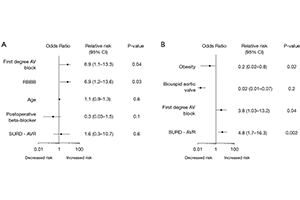Conduction disorders after aortic valve replacement: what is the real impact of sutureless and rapid deployment valves?
Abstract
Background: Although sutureless and rapid deployment aortic valve replacement (SURD-AVR) has been associated with an increased rate of permanent pacemaker (PPM) implantation compared to conventional AVR (c-AVR), the predictors of new conduction abnormalities remain to be clarified. This study aimed to identify risk factors for conduction disorders in patients undergoing AVR surgery.
Methods: Data from 243 patients receiving minimally invasive AVR were prospectively collected. SURD-AVR was performed in 103 (42.4%) patients and c-AVR in 140 (57.6%). The primary end-point was the occurrence of new-onset conduction disorders, defined as first degree atrioventricular (AV) block, advanced AV block requiring PPM implantation, left anterior fascicular block (LAFB), left bundle branch block (LBBB) and right bundle branch block (RBBB).
Results: The unadjusted comparison revealed that SURD-AVR was associated with a higher rate of advanced AV block requiring PPM when compared with c-AVR (10.5% vs. 2.1%, P=0.01). After adjusting for other measured covariates (OR: 1.6, P=0.58) and for the estimated propensity of SURD-AVR (OR: 5.1, P=0.1), no significant relationship between type of AVR and PPM implantation emerged. On multivariable analysis, preoperative first-degree AV block (OR: 6.9, P=0.04) and RBBB (OR: 6.9, P=0.03) were independent risk factors for PPM. Subgroup analysis of patients with normal preoperative conduction revealed similar incidence of PPM between SURD-AVR and c-AVR (1.3% vs. 1.9%, P=0.6). When compared with c-AVR, SURD-AVR was associated with a greater incidence of postoperative new onset LBBB (18.1% vs. 3.2%, P<0.001). This finding was confirmed after adjusting for the estimated propensity of SURD-AVR (OR: 6.3, P=0.009).
Conclusions: Our study revealed that the risk of PPM implantation in patients receiving surgical AVR is heavily influenced by the presence of pre-existing conduction disturbances rather than the type of valve prosthesis. Conversely, SURD-AVR emerged as an independent predictor for LBBB and was associated with an increased risk of PPM in patients presenting with RBBB.
Cover






